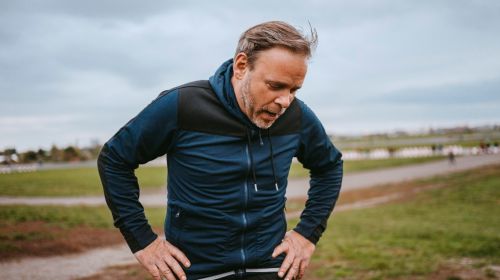A sudden feeling of not getting enough air or constant difficulty breathing even with minimal physical exertion: Shortness of breath (dyspnea) can manifest itself in different ways and have different causes. Learn when to seek medical attention and what to do in an emergency!
- © Syda Productions – stock.adobe.com
Quick overview: Frequently asked questions and answers
What causes shortness of breath during low exertion? Shortness of breath that occurs with even mild exertion can indicate serious heart or lung disease. Older people in particular often suffer from shortness of breath caused by heart failure.
When is shortness of breath dangerous? Shortness of breath becomes dangerous when it occurs suddenly, without an apparent cause or at rest, especially in conjunction with coughing up blood, chest pain, dizziness or blue lips.
What to do if you have shortness of breath? Stay calm, sit comfortably and take deep breaths. If shortness of breath is severe or worsens, call emergency medical attention.
Article contents at a glance:
Definition: What is dyspnea?
Dyspnea is the subjective experience of shortness of breath or difficult breathing. Those affected have the feeling that they are not getting enough air, even though they are breathing harder. The symptom can have many different causes, but experts are not always able to diagnose an exact trigger.
Frequency of shortness of breath
Shortness of breath is one of the most common symptoms that prompts sufferers to seek medical advice. In around 1 to 4 percent of cases, dyspnea is the reason for a visit to the family doctor’s office. In the emergency room, around 7 percent report shortness of breath. The proportion of those affected increases with age.
Acute and chronic dyspnea
Experts differentiate between acute and chronic dyspnea.
Acute shortness of breath occurs within a few minutes or hours and is classified as an emergency. Possible causes include an asthma attack or a pulmonary embolism.
Chronic dyspnea is described as difficulty breathing that lasts longer than a month. These can be due, for example, to heart failure or chronic obstructive pulmonary disease (COPD).
Other forms of dyspnea
Depending on the circumstances of occurrence, further forms are defined:
Resting dyspnea: Shortness of breath at rest, without physical exertion
Speech dyspnea: frequent gasping for air while speaking
Stress dyspnea: Shortness of breath under physical stress (e.g. when lyeing or climbing stairs)
Orthopnea: increased shortness of breath when lying down, so that the affected person is forced to sit upright.
Symptoms: How can shortness of breath manifest itself?
Dyspnea is described by those affected as the feeling of not getting enough oxygen. Possible external signs can include shallow, rapid or very deep breathing. For patients with asthma, exhalation in particular usually requires great effort.
An increased heart rate can also occur if you are short of breath. If there is a lack of oxygen, a bluish discoloration of the skin, mucous membranes or lips is also possible.
Depending on the cause, additional symptoms may arise, such as:
- dizziness
- Chest pain
- Chest tightness
- heart racing
- Cough
- Fear or panic
Shortness of breath: Possible causes of dyspnea
© FUNKE Digital Video
Dyspnea: causes and risk factors
Breathing is a complex process that involves not only the lungs but also the nervous system, the respiratory muscles and the cardiovascular system. Accordingly, shortness of breath can have many different causes.
The following diseases, for example, can be associated with shortness of breath:
Dyspnea due to respiratory diseases
Dyspnea due to cardiovascular disease
Other causes or triggers for dyspnea
- Allergies
- Foreign bodies in the respiratory tract
- ketoacidotic coma (hyperglycemia in diabetes mellitus)
- Side effects of medication (for example from levofloxacin, an antibiotic drug)
- neurological diseases
- Psychologically caused hyperventilation, for example during panic attacks
- Smoke inhalation
- Rib fracture
- Sleep apnea
- poor fitness level
- Pains
- Overweight
- Vertebral blockage
Treatment: What to do if you have acute and chronic shortness of breath?
Acute, severe shortness of breath is always an emergency. In this case, first aiders should react as follows:
- Call emergency number 112
- Calm the affected person
- Place in a sitting position or with your upper body slightly raised
- Open tight clothing (such as a tie).
- provide fresh air supply
- If available: use emergency medication such as asthma sprays
Under certain circumstances, acute life-saving first aid measures with emergency ventilation, chest compressions or defibrillation of the heart are necessary.
First aid for hyperventilation
For people who hyperventilate, i.e. who breathe in faster than is necessary to supply the body and break down carbon dioxide, breathing into a bag can be helpful. As a result, some of the excess carbon dioxide exhaled is rebreathed in and breathing slows down.
Medical treatment for shortness of breath
In the case of shortness of breath that is due to diseases of the respiratory tract, heart or psyche, treatment depends on the underlying cause. Some examples:
Antibiotics help with bacterial respiratory diseases, such as pneumonia.
Bronchial asthma or COPD are diseases that narrow the airways. Therefore, medications that expand the bronchi are primarily used.
Heart valve disease often requires surgical treatment.
In the case of psychological shortness of breath, sedative medication can be used as directed by a doctor. Psychotherapy is also often recommended.
Diagnosis of shortness of breath
A detailed survey (anamnesis) is crucial for the diagnosis, in which, among other things, accompanying symptoms and possible previous illnesses are recorded.
The doctor then carries out a physical examination. Particular attention is paid to signs of impaired breathing (breathing frequency, depth of breathing, breathing noises), the severity of the shortness of breath and signs of oxygen deficiency (paleness or blue discoloration of the skin, cold sweats, restlessness). The lungs and heart are also listened to.
In addition, other examinations can be used:
Blood gas analysis
further blood tests (for example, provide information about blood clotting, blood sugar, condition of the kidneys and liver)
Electrocardiogram (ECG) to determine whether shortness of breath is due to heart disease
Lung function tests (e.g. if bronchial asthma is suspected)
X-ray or ultrasound examination of the lungs
Computed tomography (CT) of the lungs
Mirroring the bronchi (bronchoscopy)
Assessment of dyspnea according to severity
When making the diagnosis, shortness of breath is also assessed according to its severity. For this purpose, the individual feeling of shortness of breath (Borg scale) can be assessed. The American Thoracic Society’s ATS scale also takes into account resilience during physical exertion.
Can shortness of breath be prevented?
A healthy lifestyle can help reduce the risk of shortness of breath. The first priority is to avoid smoking, as smoking significantly increases the risk of lung diseases such as chronic obstructive pulmonary disease (COPD).
Many underlying diseases that can lead to shortness of breath occur less frequently with a healthy lifestyle. A balanced diet, normal weight and regular exercise are therefore factors that reduce the likelihood of shortness of breath.


